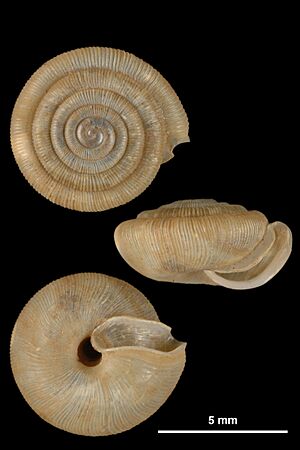Trissexodon constrictus facts for kids
Quick facts for kids Trissexodon constrictus |
|
|---|---|
 |
|
| Shell of Trissexodon constrictus (specimen at MNHN, Paris) | |
| Conservation status | |
| Scientific classification | |
| Kingdom: | |
| Phylum: | |
| Class: | |
| (unranked): |
clade Heterobranchia
clade Euthyneura clade Panpulmonata clade Eupulmonata clade Stylommatophora informal group Sigmurethra |
| Superfamily: |
Helicoidea
|
| Family: |
Trissexodontidae
|
| Genus: |
Trissexodon
|
| Species: |
T. constrictus
|
| Binomial name | |
| Trissexodon constrictus (Boubée, 1836)
|
|
| Synonyms | |
|
Helix constricta Boubée, 1836 |
|
Trissexodon constrictus is a small, air-breathing land snail. It is a type of mollusk that lives on land, not in water. This snail belongs to a group called gastropods and is part of the family Trissexodontidae.
Contents
Where Does This Snail Live?
This special snail is only found in a specific part of Europe. It lives in the western Pyrenees mountains and the Basque Country. You can find it in many places across Spain, especially in the Basque Mountains. It also lives in France, in the areas of Hautes-Pyrénées and Pyrénées-Atlantiques.
What Does Trissexodon constrictus Look Like?
The shell of this snail is quite unique. It has fine, regular ridges all over it. The top part of the shell is very flat, while the bottom part is rounded.
Shell Features
- The shell has about 5 to 6 whorls, which are the spiral turns of the shell.
- The opening of the shell, called the aperture, has a special shape.
- The edge of the opening, called the lip, is folded back. It looks like a "U" shape when you view it from above.
- The umbilicus is a deep hole in the center of the shell's underside. It covers about one-seventh of the shell's total width.
Size of the Snail Shell
This snail is quite small!
- The shell is usually about 6 to 8 millimeters wide.
- The height of the shell is about 3 to 4 millimeters.
Where Can You Find Trissexodon constrictus?
Trissexodon constrictus likes to live in specific places. It is often found under stones in the soil. These snails prefer humid and shady forests where trees lose their leaves in autumn.
Snail Habitat
- You might spot them among moss or under layers of fallen leaves.
- Sometimes, they are even found near the openings of caves.
- These snails can live from sea level up to about 800 meters high.
- Very rarely, they have been seen at even higher altitudes, up to 1500 meters.


